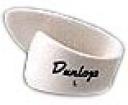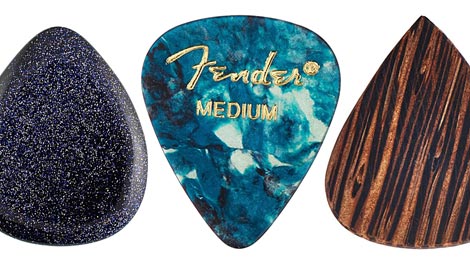Why A Pick?
A guitar pick, or plectrum is used to pluck, or strum guitar strings; to improve sound, allow faster strumming, and reduce injury on fingers. You can just use your fingers, especially for picking, but a pick gives far more bite to notes, and hurts a lot less. There are many types of guitar picks to choose from: different materials, shapes, as well as sizes and colors. Some guitar picks are even used for special purposes, such as a double-sided pick for “double plucking.” This article explores some of the diffent types.
Different types of Guitar Pick
Guitar picks are commonly made out of plastic, but also wood, bone, amber, rubber, felt, tortoiseshell, stone, metals, and even gemstones. Each of the materials has it’s own unique sound, but also properties such as ease of grip, price, and durability. There is no one type to suit all players – playing style, and desired tone are important when choosing. For instance, metal has a very distinct bright sound when plucked against a guitar string and makes for great piercing solos – but offers little grip. It can also damage a guitars finish if played too aggressively. Wood picks are cheap, with great grip, nice attack, and a full woody sound – great for jazz. Actually woods tonal qualities can vary hugely from species to species, and as they are so cheap, buying a selection of different types is quite affordable. Tortoiseshell was historically one of the best materials in terms of grip and tone, although an international ban on tortoise shell (rightly so) led to the creation of Tortex picks, which are a pretty good all round replacement. Leather picks offer a rather mellow muted sound great for strumming chords, but too flexible when playing individual notes.
Choosing your most suited material is a matter of trying them all out, and deciding on which sound and grip works for your playing style – whether it be metal, blues, or jazz. Many players have a selection of picks, using different ones at different times. If all else fails, weird guitar picks aren’t unheard of – from bone, to an Allen wrench – just about anything can become a useable plectrum!



Figure 1 – Traditional picks, a thumb pick, and a triangle pick example
Different gauges of guitar pick
The thickness of a guitar pick is very important. For instance, a thicker pick will give a harder sound, with more attack, and more control in tone, while a thinner pick will give more of a random and uncontrollable sound, but allows faster picking. Hard rock or metal players usually prefer thin picks – especially if they like to play fast riffs. These guitarists usually favour thinner strings, but players who use thicker gauges will often need thicker picks. Likewise, bass guitarists usually use thick picks. Thinner picks give less power, and have less durability- especially with complex techniques such as tremolo picking.
There are a few shapes and sizes to picks, as well. A shark’s fin pick will allow the use of pick scraping to be much easier. A sharp edged pick will give an edgier sound to one’s playing style. The equilateral pick is perfect for beginners- as it has no special qualities to master, and each corner can be used to play the guitar with. Some picks even wrap around an entire finger- such as the thumb pick that is available.
D’Andrea picks were the first to actually offer things such as custom imprinting, and developed many of the shapes and materials of picks that are still in use today. D’Andrea picks are still available today, since 1922. From the customization D’Andrea picks started, other companies have followed suit. Today, there are hundreds of styles, shapes, colors, and sizes of picks. In fact, picks made of precious gems are available toda. Of course, these picks don’t flex or bend- but they offer a unique sound and are very durable.
Guitar picks are plentiful, and usually only cost a few dollars for a dozen of them. Some of the most mainstream picks are offered by Fender, and some less mainstream picks such as the Joe Satriani line of picks are available- although they cost more money. Choosing the guitar pick is the first step in mastering the guitar, and the next step would be to master picking techniques. It should be noted that if a more extravagant pick is desired, such as the gemstone picks, that you should make sure you don’t lose them- consider it a piece of good advice, picks are usually lost before they are broken.


I agree that choice of picks is up to the guitarist and every guitarist has his own favorite style of pick. Even though heavy guitar picks have better control for some things, thin guitar picks are better for some things. You usually get a more soothing strum out of a thin pick. I personally shoot for the middle ground and use medium fender picks.
The Digital Guitar
Don’t metal picks and stone picks damage strings? Are you more likely to break a string in performance? Nylon picks are best